Introduction
Brynje (pronounced brin-ya) is a Norwegian company specializing in base layers with an open-weave construction (as opposed to a traditional, fine-knit construction). In an open-weave (“fishnet”) construction, perspiration vapor can be rapidly transported to outer layers. This is In contrast to solid knit construction, where perspiration vapor tends to (first) condense onto the fibers and then must be “wicked” to the outer layers.
The idea is that open-weave fabric dries faster, breathes better, and offers a higher insulation-to-weight ratio than traditional base layers. Brynje also claims that its woven products are more durable than conventional base layers.
Brynje’s products come in a range of designs and material blends. For this base layers review, I got my hands on four products:
- Unisex Wool Thermo T-Shirt Base Layer with Inlay
- Unisex Wool Thermo Light Longs Base Layer with Inlay
- Unisex Super Thermo T-Shirt Base Layer with Inlay
- 70 Gram Wool Hat
At this point, since nomenclature can sometimes be confusing, it’s important to note that:
- Wool Thermo is a blend of (predominantly) merino wool and nylon (for durability).
- Super Thermo is a polypropylene fabric (lowest water absorption).
- Inlays are solid fabric panels that have been sewn into the shoulders of torso garments (for more comfort under a pack strap) and into the crotch panels of leggings (presumably, for some measure of modesty).
Together these products form a complete base layer sleep system (minus socks) and represent a well-rounded sampling of Brynje’s design aesthetic, manufacturing quality, and material choice.
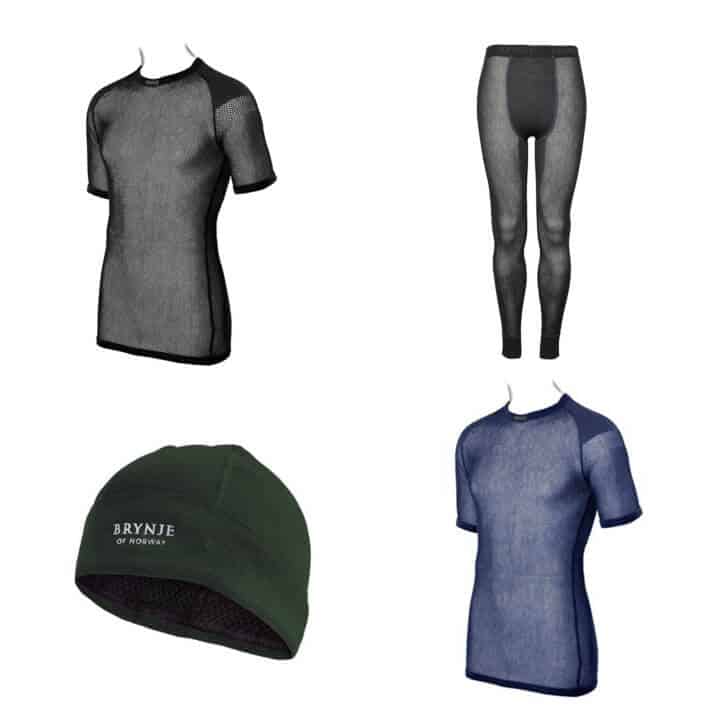
Features and Specifications
Features
- Wool Thermo T-Shirt
- Open-weave mesh fabric
- Wool/synthetic blend
- Solid knit inlay at shoulders
- Long cut falls well below the waist
- Drop hem (in addition to long cut)
- Snug, athletic fit – very stretchy
- Unisex
- Super Thermo T-Shirt
- Open-weave mesh fabric
- Synthetic
- Solid knit inlay at shoulders
- Drop hem
- Snug, athletic fit – very stretchy
- Wool Thermo Light Longs (leggings)
- Open-weave mesh fabric
- Wool/synthetic blend
- Solid knit inlay at crotch and knees
- Elastic bands at waist and ankles
- Snug, athletic fit – very stretchy
- Unisex (no fly)
- 70 Gram Lined Hat
- Open-weave mesh liner
- Knit wool/synthetic blend shell
- Extra fabric available for pulling down over ears and neck
- Snug fit, slightly stretchy
Specifications
- Wool Thermo T-Shirt (size medium)
- Weight (claimed): 3.9 oz (110 g)
- Weight (measured): 4.2 oz (119 g)
- Material: 80% merino wool and 20% polyamide
- Fabric: knit, 3/8 in (1 cm) open-weave mesh, 3.7 osy (125 gsm)
- Super Thermo T-Shirt (size small)
- Weight (claimed): 3.9 oz (110 g)
- Weight (measured): 4.0 oz (113 g)
- Material: Schoeller® Polycolon® synthetic yarn (polypropylene)
- Fabric: knit, 3/8 in (1 cm) open-weave mesh, 4.1 osy (140 gsm)
- Wool Thermo Light Longs (leggings) (size small)
- Weight (claimed): 5.2 oz (150 g)
- Weight (measured): 4.2 oz (119 g)
- Material: 80% merino wool and 20% polyamide
- Fabric: knit, 3/8 in (1 cm) open-weave mesh, 3.7 osy (125 gsm)
- 70 Gram Lined Hat (size large)
- Weight (claimed): 2.5 oz (70 g)
- Weight (measured): 2.4 oz (68 g)
- Material and Fabrics:
- Shell: solid knit, 80% merino wool and 20% polyamide
- Lining: knit, 3/8 in (1 cm) open-weave mesh polypropylene Super Thermo Mesh
Review Context
Clothing in the outdoor industry seems susceptible to hard-to-prove, occasionally outrageous claims. Just recently, Smartwool released Intraknit, which they claim is “the biggest innovation in apparel manufacturing in 200 years*.”
Bold talk – but representative of the kind of hyperbole the outdoor industry seems to reserve for apparel. Brynje is a little less extreme with their advertising copy. But they still claim that their open-weave concept dries faster, is more robust, and provides the same warmth for less weight than solid knit base layers.
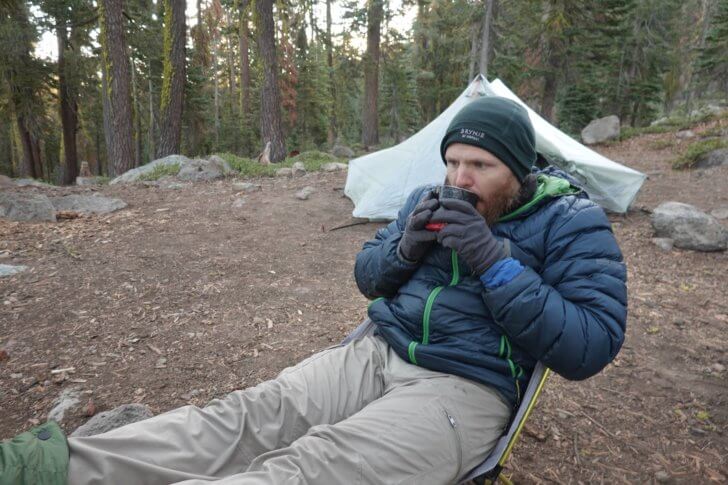
I tested these claims as well as I could outside of laboratory settings. Like most serious backpackers, I’m a long-time user of base layers. I tend to hike in them in addition to sleeping in them. I hike hot, so I like the breathability and comfort that a base layer affords as a primary hiking garment.
In 2012 I completed a thru-hike of the Appalachian Trail while hiking and sleeping in Patagonia’s synthetic Capilene Cool base layer system (at the time it was called Capilene One). Since then, I’ve completed a few more thru-hikes and dozens of shorter trips in Smartwool and Icebreaker base layers.
I’m a fan of wool or wool-blend base layers. But apparently, my sweat is slightly acidic, and when combined with pack-strap abrasion and bushwhacking, thinner wool knit garments tend to rot off my body within a few months of heavy use. I wish I had pictures of the lower back, belly, and underarm holes in all my merino base layers, but my wife has permanently banished these offensive items of clothing from our cabin.
So, while I was interested in testing Brynje’s warmth, comfort, and fast-drying claims, I was particularly excited to see how the products held up over a long period of backcountry use. I tested these four garments in various configurations and situations over a year of sleeping and hiking – mostly in alpine zones in California and Montana.
*Note – this claim initially appeared on a Smartwool Facebook advertisement, and seems to have disappeared in the weeks since I first came across it.
Commentary
Wool Thermo T-Shirt (size medium)
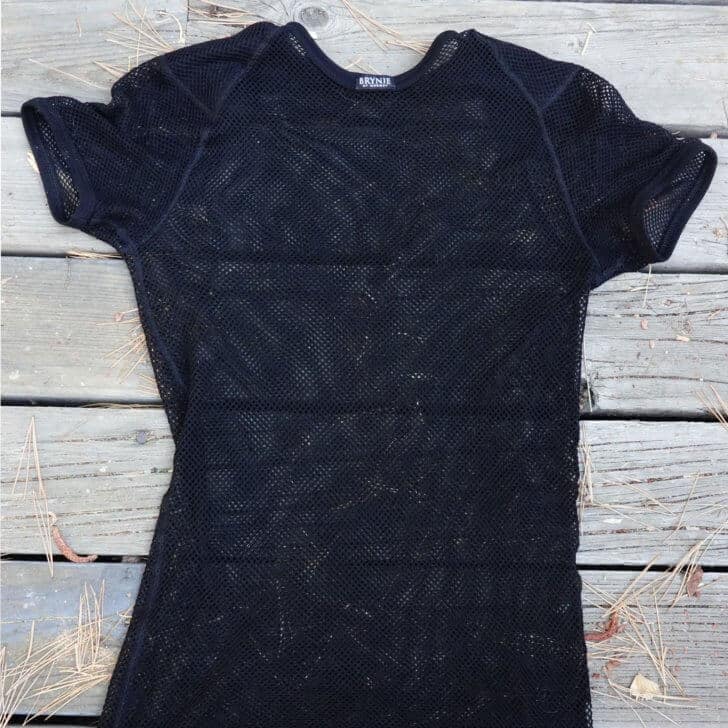
The Wool Thermo T-Shirt is Brynje’s mid-weight mesh base layer. It also comes in long-sleeved and women’s-specific versions. The women’s version has a large solid knit front panel for modesty.
Indeed, this is not necessarily the base layer you want to be hiking in without anything covering it. The mesh pores measure 3/8 in (1 cm) in diameter – which is plenty large enough to show some skin. So maybe save Brynje products for sleeping, layering underneath other garments, remote expeditions, or, if you are feeling saucy, western Europe.

The fit is snug. My body type (5 ft 6 in / 168 cm, and an athletic 165 lb / 75 kg) hovers between needing small and medium sizes, depending on the product’s cut. For Brynje, I needed mediums. If you are a border-line size, I’d recommend choosing the larger one.
Although snug-fitting, the Wool Thermo T-shirt has plenty of stretch. The result is a form-fitting garment that is soft against the skin. The double-stitched seams are flat, and they never chafed or rubbed while wearing a pack. Thicker, solid knit inlay panels in the shoulders ensure that the mesh doesn’t chafe against the shoulders while wearing a pack.
The Wool Thermo T-Shirt features a long cut – it might be the longest-cut base layer I’ve ever used. I like this design element. I want my layers to stay in place during high-exertion activity, particularly my base layers. The Wool Thermo T-shirt’s hem falls well below the hips, allowing it to securely tuck into other base layers or hiking pants (or skirts, or kilts).
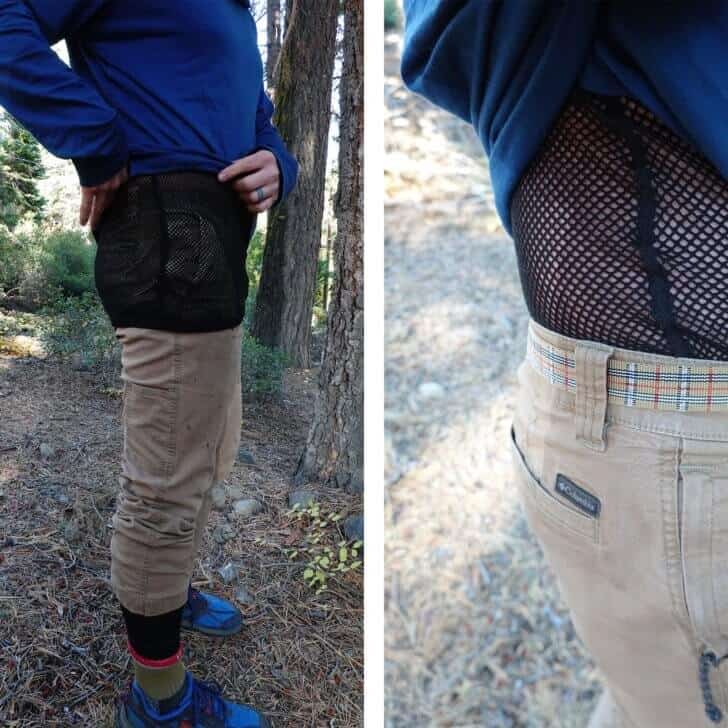
The garment has a drop hem in addition to its extended cut – given all that, I think you’d be challenged to feel a draft while wearing this layer as a result of the hem riding up.
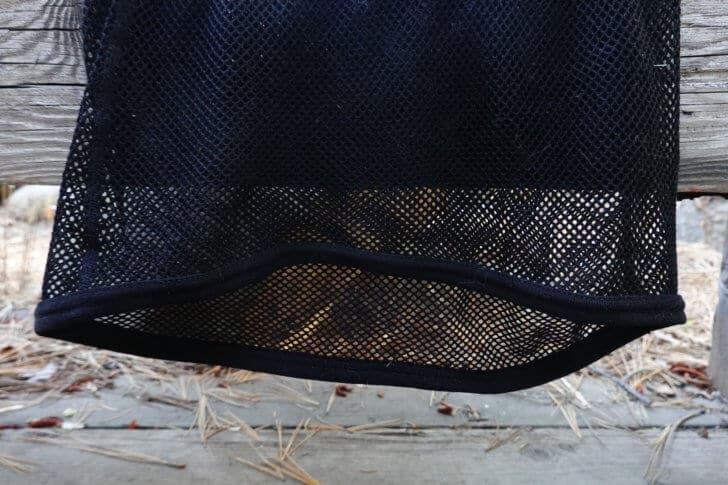
Member Exclusive
A Premium or Unlimited Membership* is required to view the rest of this article.
* A Basic Membership is required to view Member Q&A events

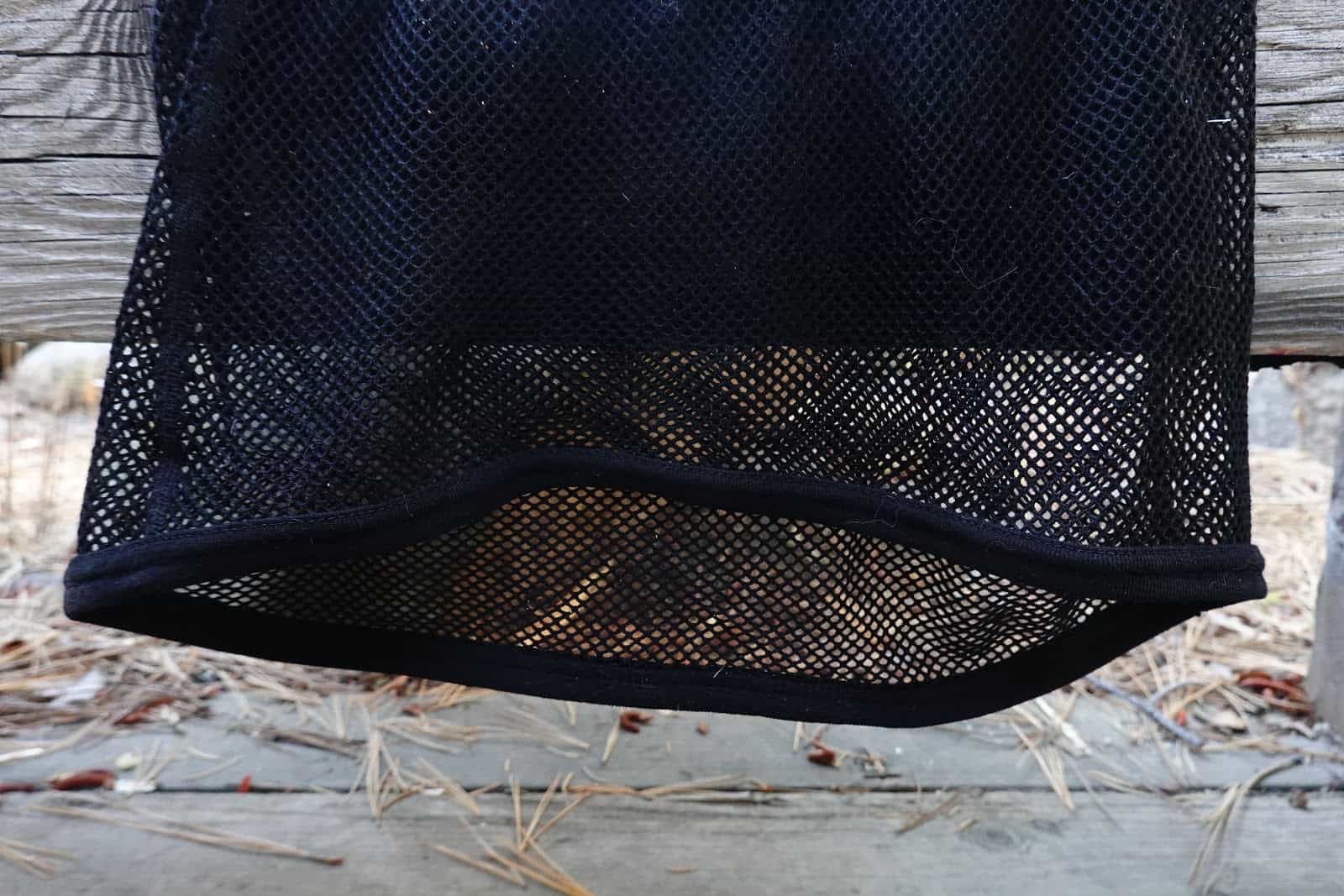


Home › Forums › Brynje Thermo Mesh Review (Wool and Synthetic Base Layers)